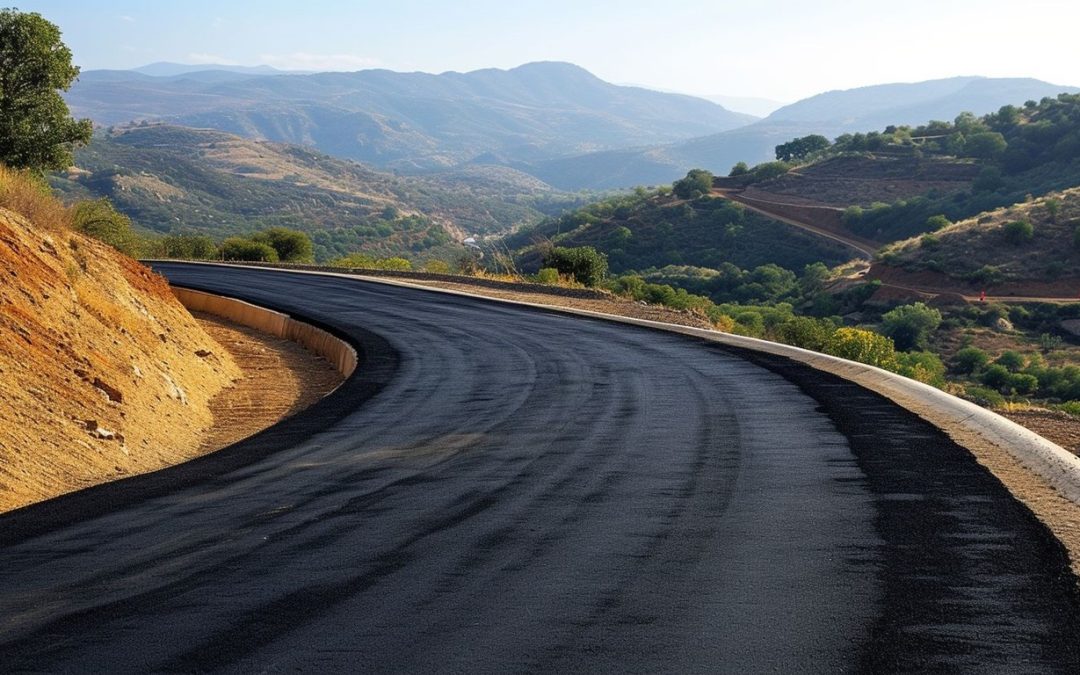Cracked and crumbled driveways—everyone’s been there, right? Asphalt paving might just be your superhero in disguise. From lush, smooth blacktops to sturdy, pothole-free parking spaces, this guide peels back the layers of asphalt for a top-notch paved paradise.
Stay with us; we’re laying the groundwork for something great!
Why Choose Asphalt for Paving?
Asphalt shines as a top pick for paving because it’s tough and fights off tire marks. Imagine your driveway staying smooth and strong, even when big trucks roll by; that’s what asphalt brings to the table.
Plus, it doesn’t take forever to set up. Crews can lay down an asphalt road or fix up your driveway pretty quick, which means less waiting around for you.
Now let’s talk money – choosing asphalt saves you cash upfront compared to concrete. And guess what? Asphalt is like the superhero of recycling; every bit of it can take on a new life in fresh pavement.
That’s good news for both your wallet and the planet! So if you’re eyeing a new look for your drive or patching up some potholes, asphalt might just be your best bet.
Key Components of Asphalt Paving
Diving headfirst into the world of asphalt paving, there’s more going on than meets the eye—from the intricate dance of heavy machinery to the symphony of materials that create that smooth, blacktop masterpiece.
It’s a process where precision meets hard work, and I’ll give you the lowdown without getting your boots dirty.
Materials Used
Asphalt paving needs some tough stuff. Think of it like making a giant, strong cookie that cars can drive on. You need the right mix of ingredients to make it just right. Now, we’re not talking flour and sugar here, but stuff like crushed rock, sand, and gravel — folks call this ‘aggregate.’ It’s what gives asphalt pavement its muscle.
Then you stir in asphalt binder; it’s the sticky glue that holds everything together.
You might have heard about recycled asphalt—it’s the eco-friendly hero of paving! Old roads get broken up but don’t go to waste; they become part of new ones. This recycled mix isn’t just good for the planet; it makes stronger roads too.
And hey, there are different recipes out there: hot mix asphalt is perfect for those sunny days; cold mix asphalt works when it’s chilly outside; porous asphalt even lets water drain through so puddles don’t form.
So yeah, choosing materials is a big deal because getting them right means smoother drives and longer-lasting roads for parking lots or airport runways!
Equipment Required
To get the asphalt down smooth and solid, you need some heavy-duty gear. Think about tough machines like a Flatliner for fixing old roads or a Milling Machine when you’ve got to scrape away what’s there already.
That Mountain States Asphalt Paving, Inc., they’ve got it all – pavers, rollers, backhoes, even those big loaders and graders.
You can bet that laying down a new driveway or patching up an old parking lot takes more than just a strong back — you need sweepers to clean up and skid steers for the nitty-gritty.
The Paving Process
The paving process starts with getting the ground ready. Workers clear away plants and topsoil to make way for new roads or driveways. They lay down layers of crushed stones, which they call subbase, creating a stable base.
After that, it’s time to put down asphalt.
Asphalt pavers come rumbling in like big hungry machines ready for a feast! They spread out either hot mix asphalt or recycled asphalt mix on the prepared base. The warm mix is popular because it’s easier on our planet and tough as nails once set.
Benefits of Asphalt Paving
Durability
So, you’re thinking about asphalt for your driveway or road—and you want it to last. Good news! Properly installed by pros, asphalt pavements can go strong for 15 to 20 years. That’s a lot of basketball games and bike rides with hardly any worry.
Keep up with the regular seal coating and repairs; it’s like giving your pavement a shield against wear and tear.
Let’s talk tough stuff—recycled asphalt mix! This isn’t just good for the planet; believe it or not, it actually makes roads tougher. With solid rut resistance, these surfaces can take on more cars and trucks without breaking a sweat (or cracking).
So—that old saying “what’s old is new again”? It really means something here in the world of asphalts..
Cost-effectiveness
Saving money is a big deal when you’re paving, right? Well, asphalt’s got your back. Think of it like this: Asphalt is like those bulk deals at the store – the more you buy, the less you pay per pound.
When crude oil prices dip down low, so does the cost of making asphalt. This means laying down an asphalt driveway or path won’t have you emptying your wallet.
Now get this – not all heroes wear capes; some are recycled! Using old asphalt to make new roads doesn’t just save trees and baby seals; it makes for tougher pavement that can take a beating from trucks and weather better than first-time-around asphalt.
It’s like giving asphalt a superpower against ruts and cracks, helping it last up to 20 years with just a bit of TLC from time to time. Long story short: go with asphalt if you love saving green – both cash and trees!
Aesthetics
Asphalt isn’t just tough; it’s also got style. Picture your home with a sleek, black driveway—it’s like dressing it up in a fancy suit! It gives off that ‘wow’ vibe every time folks pass by, making them think, “These guys know what’s up!” And when you choose to lay down some asphalt, you get to pick how it looks.
Want something unique? No problem. You can mix things up to fit your own taste.
Let’s talk about keeping that spiffy look fresh. A little love goes a long way—fixing small cracks and keeping the surface clean mean your pavement will look sharp for years. Plus, there are machines made specially to make sure that when the asphalt hits the road, it does so perfectly smooth.
Think of these as giant irons smoothing out all the wrinkles on your drive or street. When we dive into how strong and wallet-friendly this stuff is next… oh boy—you’ll see why asphalt’s not just pretty but smart too!
Conclusion
So, we’ve zoomed through the world of asphalt paving and learned a bunch. If you’re a homeowner staring at some paving needs, remember this: Asphalt’s tough, kind on your wallet, and pretty snazzy to look at.





